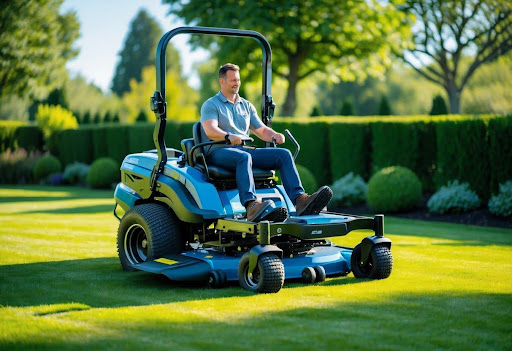To the casual observer, a stand-on mower might just look like a cross between a zero-turn and a walk-behind. But for landscaping professionals, the rise of the stand-on represents a major leap forward in efficiency, maneuverability, and comfort. These machines have become the go-to choice for many crews because they offer an incredible blend of speed and agility, allowing operators to navigate complex properties with ease.
This high level of performance isn’t an accident. It’s the direct result of sophisticated technology and engineering packed into every component. Modern stand-on mowers are far more than just a deck and an engine; they are a complex system of advanced technologies all working in concert to deliver a clean cut, reliable operation, and a comfortable ride. Understanding what’s going on “under the hood” can give you a much greater appreciation for these workhorses of the turf industry.
Here’s a look at the key tech components that make these mowers a top choice for professionals.
The Heart of the Machine: The Powertrain
The engine is the heart of any mower, and commercial stand-on units are fitted with high-performance, industrial-grade power plants. You’ll typically find V-twin engines from renowned manufacturers known for their durability and torque. But the real technological leap in recent years has been the widespread adoption of Electronic Fuel Injection (EFI).
Unlike a traditional carburetor that mixes fuel and air mechanically, an EFI system uses an onboard computer and electronic sensors to constantly adjust the fuel/air mixture for optimal performance. This smart system provides several key advantages:
- Better Fuel Efficiency: An EFI engine can use up to 25% less fuel than its carbureted counterpart, which translates to significant cost savings over a long season.
- Reliable Starting: EFI eliminates the need for a manual choke, providing easier and more reliable starts in any weather condition, from cold spring mornings to hot summer afternoons.
- Consistent Power: The system automatically adapts to engine load and conditions, delivering smoother, more consistent power to the blades and wheels.
The Muscle: Hydrostatic Transmissions
The incredible maneuverability of a stand-on mower is made possible by its hydrostatic transmission. Instead of a system of belts and gears, a hydrostatic drive uses hydraulic fluid to transfer power from the engine to the wheels. Each drive wheel is typically powered by its own independent hydraulic pump and motor.
This technology is what allows for the zero-turn capability. By controlling the flow of fluid to each wheel independently, an operator can pivot 360 degrees in place, trim closely around trees and flowerbeds, and quickly reverse direction. It provides smooth, stepless control over speed and direction, which is essential for efficient mowing on complex properties. As industry publications like Turf Magazine often detail, the durability and performance of these transmissions are critical to a mower’s productivity.
The Foundation: The Operator Platform
The “stand-on” design itself is a piece of ergonomic technology. It provides excellent visibility, allows the operator to easily shift their weight for stability on hills, and makes it quick to hop on and off the machine to move obstacles. But a quality stand-on goes a step further by isolating the operator from the bumps and vibrations of the job.
Advanced operator platforms are often cushioned and feature an integrated suspension system with components like coil springs and shock absorbers. This system absorbs the impacts from rough terrain, significantly reducing operator fatigue over a long day of mowing. A comfortable operator is a more productive and focused operator, and this suspension technology is a key factor in all-day comfort.
The Business End: The Cutting Deck
A commercial mower deck is a highly engineered piece of equipment. Unlike the thin, stamped decks found on residential mowers, commercial decks are fabricated from heavy-gauge, welded steel for maximum durability.
But the real tech is in the aerodynamics. The shape of the deck, the design of the baffles inside, and the form of the cutting blades are all engineered to work together. They create a powerful vacuum effect that pulls the grass blades upright for a clean, precise cut. This airflow also ensures that clippings are efficiently discharged from the side or mulched into fine pieces, preventing clumps and leaving behind a professional-quality finish. The engineering behind deck design is a frequent topic in industry publications like Lawn & Landscape.
A modern stand-on mower is a testament to how advanced technology can be applied to a seemingly simple task. From the fuel-injected engine to the suspended operator platform, every component is designed to maximize efficiency, durability, and performance, which is why they have become such an indispensable tool for landscaping professionals.



































